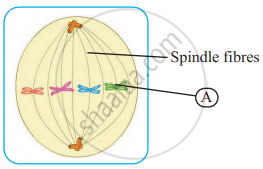Advertisements
Advertisements
Question
Answer the following question.
Enlist the different stages of prophase – I.
Solution
It is the most complicated and longest phase of the meiotic division. It is further divided into five sub-phases viz. leptotene, zygotene, pachytene, diplotene and diakinesis.
- Leptotene:
The volume of the nucleus increases. The chromosomes become long distinct and coiled. They orient themselves in a specific form known as bouquet stage. This is characterized by the ends of chromosomes converged towards the side of the nucleus where the centrosome lies. The centriole duplicates into two and migrates to opposite poles.
- Zygotene:
Pairing of non-sister chromatids of homologous chromosomes takes place by the formation of the synaptonemal complex. This pairing is called synapsis. Each pair consists of a maternal chromosome and a paternal chromosome. Chromosomal pairs are called bivalents or tetrads.
- Pachytene:
Each individual chromosome begins to split longitudinally into two similar chromatids. Therefore, each bivalent now appears as a tetrad consisting of four chromatids. The homologous chromosomes begin to separate but they do not separate completely and remain attached to one or more points. These points are called chiasmata (Appear like a cross-X). Chromatids break at these points and broken segments are exchanged between non-sister chromatids of homologous chromosomes resulting in recombination.
- Diplotene:
The chiasma becomes clearly visible in diplotene due to the beginning of repulsion between synapsed homologous chromosomes. This is known as desynapsis. Synaptonemal complex also starts to disappear.
- Diakinesis:
The chiasmata begin to move along the length of chromosomes from the centromere towards the ends of chromosomes. The displacement of chiasmata is termed as terminalization.
The terminal chiasmata exist till the metaphase. The nucleolus and nuclear membrane completely disappear and spindle fibres begin to appear.
APPEARS IN
RELATED QUESTIONS
Answer the following question.
While observing a slide, student observed many cells with nuclei. But some of the nuclei were bigger as compared to others but their nuclear membrane was not so clear. Teacher inferred it as one of the phase in the cell division. Which phase may be inferred by the teacher?
Answer the following question.
Students prepared a slide of onion root tip. There were many cells seen under a microscope. There was a cell seen under a microscope. There was a cell with two groups of chromosomes at opposite ends of the cell. This cell is in which phase of mitosis?
Answer the following question.
Students were observing a film on Paramoecium. It underwent a process of reproduction. Teacher said it is due to cell division. But students objected and said that there was no disappearance of the nuclear membrane and no spindle formation, how can it be cell division? Can you clarify?
Answer the following question.
Is the meiosis responsible for evolution? Justify your answer.
Answer the following question.
Why mitosis and meiosis – II are called as homotypic division?
Draw labelled diagrams and write an explanation.
Distinguish between mitosis and meiosis.
Draw labelled diagrams and write an explanation.
Draw the diagram of metaphase.
Is a given figure correct? why?

If an onion has 16 chromosomes in its leaf cell, how many chromosomes will be there in its root cell and pollen grain?
Identify the following phase of mitosis and label the ‘A’ given in the diagram.

